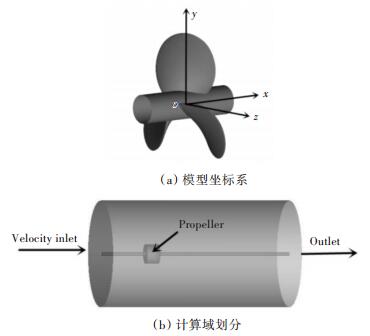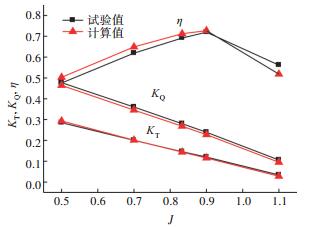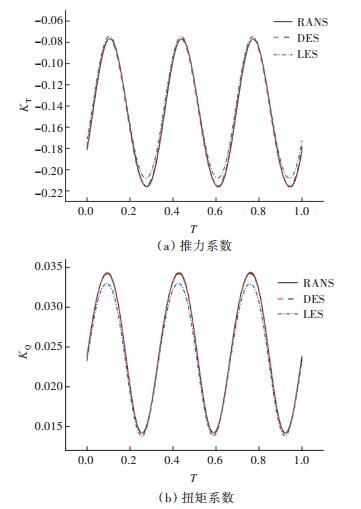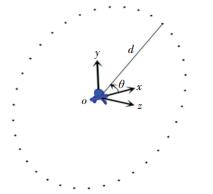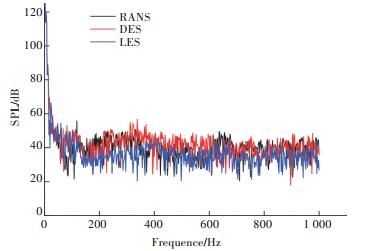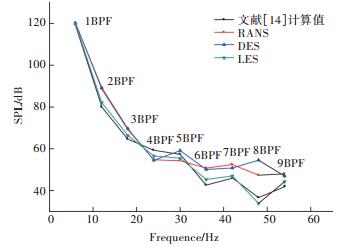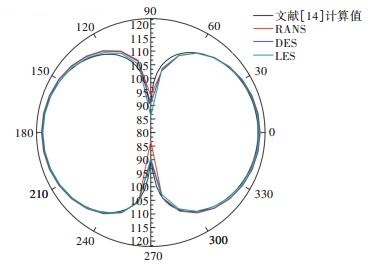Applicability of RANS, DES and LES in propeller flow noise
-
摘要:目的 为研究不同湍流模型在螺旋桨流噪声预报中的适用性,以DTMB 4119螺旋桨为研究对象,对非均匀进流条件下的频域噪声进行数值模拟。方法 首先,采用RANS方法计算螺旋桨在不同进速下的水动力系数和桨叶表面压力分布,并将仿真值与试验值进行比较,验证流场模拟的准确性;然后,分别将RANS,DES和LES这3种方法得到的脉动压力作为声源,结合声学边界元预报辐射噪声。结果 计算结果表明,线谱噪声是螺旋桨总噪声的主要贡献者;当预报一阶叶频上的噪声时,3种方法所得结果较为接近,可以采用RANS方法进行快速预报;当预报高阶叶频上的噪声时,采用LES方法预报的结果更加准确。结论 在噪声预报时可以根据需求选择合适的湍流模拟方法。Abstract:Objectives In order to study the applicability of different turbulence models in propeller flow noise prediction, taking the DTMB 4119 propeller as the research object, the numerical simulation method is used to calculate the frequency domain noise under the non-uniform flow field.Methods First, the hydrodynamic coefficient and surface pressure distribution coefficient are obtained via the RANS method and the accuracy of the flow field simulation is verified by comparing it with the experimental data. Next, the pulsating pressures obtained by RANS, DES and LES are considered as the sound source respectively, and combined with the acoustic boundary element method to predict the radiation noise.Results The results show that spectral noise is the main contributor to total noise; when noise on 1 BPF is predicted, the results obtained by the three methods are very similar, so we can use RANS to predict noise quickly; when noise on the high order of BPF needs to be predicted, the calculation results of LES are better.Conclusions In noise prediction, the appropriate turbulence simulation method can be selected according to the demand.
-
Keywords:
- propeller /
- flow noise /
- turbulence simulation method /
- boundary element
-
0. 引言
螺旋桨是舰船三大噪声源之一,对其进行噪声预报是舰船声学设计过程中的一个重要环节[1-2],国内外学者开展了大量相关研究。在理论方法的预报方面,Seol等[3-4]采用面元法得到螺旋桨的流场信息并将其代入声类比方程中求解流场任一点的辐射噪声,通过对比单极子、偶极子和四极子声源产生的噪声声压级,得到了螺旋桨流噪声主要是由偶极子声源引起的结论;张永坤等[5-6]在此基础上将螺旋桨空化时的气泡体积脉冲视为偶极子,通过求解声类比方程,研究了螺旋桨空泡噪声和非空泡噪声特性。在数值模拟的预报方面,Pantle等[7]设计了一款简易螺旋桨并测量了其在空气中工作时的噪声数据,之后采用商业软件对该桨噪声进行计算,发现计算值和试验值基本吻合,在叶频和倍叶频上吻合较好,验证了数值方法的可行性。然而,由于螺旋桨在水中工作时的情况较为复杂,目前的试验技术和设备还无法准确测量噪声信号,因此缺乏水下试验数据。张明宇等[8]采用大涡模拟法(Large Eddy Simulation,LES)与声学边界元相结合的方法预报了艇后螺旋桨辐射噪声,并将仿真值与理论计算值进行了对比,两者吻合较好;王超等[9]采用LES和声学无限元相结合的方法对螺旋桨噪声进行了数值预报。
无论采用理论方法还是数值模拟方法预报螺旋桨流噪声,都要先求解螺旋桨的湍流脉动,而在数值模拟方法中,湍流脉动的准确性又取决于湍流模拟方法。目前,在数值模拟中应用最为广泛的是LES方法,该方法对网格要求高、计算量较大、计算效率偏低。因此,本文拟以DTMB 4119螺旋桨为对象,采用雷诺平均N-S(Reynolds Average Navier-Stokes,RANS)方程、分离涡模拟法(Detached Eddy Simulation,DES)和LES这3种湍流模拟方法计算湍流脉动,并通过声学边界元预报螺旋桨流噪声,研究湍流模拟方法对流噪声预报的影响。
1. 数学模型
1.1 RANS方法
该方法对湍流的模拟比较简单,因此不适用于复杂的流场计算。将N-S方程时域平均化后即可得到RANS方程,为便于理解,除脉动值的时均值外,其他变量都去掉了表示时均值的上划线符号“—”,方程如下所示:
∂∂t(ρui)+∂∂xj(ρuiuj)=−∂p∂xi+∂∂xjμ(∂ui∂xj−ρ¯u′iu′j) (1) 式中:xi和xj(i,j=1,2,3)为三维笛卡尔坐标系oxyz下的方向坐标;ui和uj为速度分量的时均值;t为时间;ρ为流体密度;p为流体微元体上的压力时均值;μ为流体的动力粘性系数;−ρ¯u′iu′j为雷诺应力。为使方程封闭,必须建立湍流模型将瞬时值与时均值联系在一起,本文采用剪切应力传输(Shear Stress Transport,SST)模型。
1.2 DES模型
DES方法将RANS方法和LES方法相结合,在边界层使用RANS方法,在分离区域则使用LES方法,以节省计算资源并保证计算的准确性。
在DES模型中,湍流动能扩散项Yk被修改为
Yk=ρβ∗kωFDES (2) FDES=max (3) 式(2)和式(3)中:β*为SST模型的一个常数;k为湍流脉动动能;ω为能量耗散率;FDES为修正系数,一般与SST模型中的混合参数值相同;CDES=0.61,为DES模型中的校准常量;Δmax=max(Δx, Δy, Δz),为局部最大网格间隙;{L_{\rm{t}}} = \frac{{\sqrt k }}{{{\beta ^*}\omega }} ,为RANS模型的湍流尺度参数。
1.3 LES方法
在运动过程中,湍流包含各种尺度的湍流结构,一般认为大尺寸漩涡在湍流场中起主导作用,而小尺寸漩涡的主要作用是扩散湍流动量。LES方法将对湍流运动进行“过滤”处理,仅对小尺度涡引入湍流模型,对大尺度涡则直接进行数值计算,以确保所得的流场信息比RANS方法更精确。
大涡模拟的控制方程由连续性方程和通过滤波函数处理过的N-S非定常方程组成:
\frac{{\partial \rho }}{{\partial t}} + \frac{{\partial \left( {\rho {{\bar u}_i}} \right)}}{{\partial {x_i}}} = 0 (4) \frac{\partial }{{\partial t}}\left( {\rho {{\bar u}_i}} \right) + \frac{\partial }{{\partial {x_j}}}\left( {\rho \overline {{u_i}{u_j}} } \right) =-\frac{{\partial \bar p}}{{\partial {x_i}}} + \frac{\partial }{{\partial {x_j}}}\left( {\mu \frac{{\partial \overline {{u_i}} }}{{\partial {x_j}}}} \right)-\frac{{\partial {\tau _{ij}}}}{{\partial {x_j}}} (5) 式中,{\tau _{ij}} = \rho \overline {{u_i}{u_i}}-\rho \overline {{u_i}{u_j}} ,为亚网格应力,其中上标“—”表示该项经过滤波。
1.4 Helmholtz方程
Lighthill于1952年提出的声类比理论没有进行任何简化和假设,其直接对N-S方程和连续性方程进行变化,得到如下非齐次波动方程:
\frac{{{\partial ^2}\rho '}}{{\partial {t^2}}}-c_0^2{\nabla ^2}\rho ' = \frac{{{\partial ^2}{\mathit{\boldsymbol{T}}_{ij}}}}{{\partial {x_i}\partial {x_j}}} (6) 式中:ρ′为由声传播或声扰动引起的流体介质的密度;c0为声在流体中的速度;Tij为Lighthill应力张量。
对式(6)进行傅里叶变换,即可得到非齐次的Helmholtz方程:
{\nabla ^2}{p_{\rm{a}}} + {k^2}{p_{\rm{a}}} =-\frac{{{\partial ^2}{\mathit{\boldsymbol{T}}_{ij}}}}{{\partial {x_i}\partial {x_j}}} (7) 式中,pa为螺旋桨壁面上的声压。
将Helmholtz方程的基本解G\left( {P, Q} \right) = \frac{{{{\rm{e}}^{-{\rm{i}}kr}}}}{{4\pi r}} 代入式(7),得
{p_{\rm{a}}} = \iiint\limits_V {{\mathit{\boldsymbol{T}}_{ij}}\frac{{{\partial ^2}G}}{{\partial {y_i}\partial {y_j}}}{\rm{d}}V}-\iint\limits_{\partial V} {{p_{\rm{a}}}\frac{{\partial G}}{{\partial b}}{\rm{d}}S} (8) 式中:\iiint\limits_V {{\mathit{\boldsymbol{T}}_{ij}}\frac{{{\partial ^2}G}}{{\partial {y_i}\partial {y_j}}}{\rm{d}}V} 为四极子源; \iint\limits_{\partial V} {{p_{\rm{a}}}\frac{{\partial G}}{{\partial b}}{\rm{d}}S}为偶极子源;G为格林函数;yi,yj和b为构造格林函数以求解数理方程问题的变量;V为边界元包络的体积;S为边界元表面。
对于低马赫数下的噪声问题,四极子源可以忽略,方程可以简化为
{p_{\rm{a}}} =-\iint\limits_{\partial V} {{p_{\rm{a}}}\frac{{\partial G}}{{\partial b}}{\rm{d}}S} (9) 2. 水动力性能计算和结果分析
2.1 计算模型和网格划分
噪声计算需要流场信息作为源项,因此先对螺旋桨的水动力性能进行计算。计算软件为CFX 16.0,计算模型为DTMB 4119螺旋桨。以螺旋桨中心为坐标原点,螺旋桨轴线为x轴,在桨盘面处分别建立y轴和z轴,基本参数如表 1所示。
表 1 螺旋桨基本参数Table 1. Propeller parameters几何参数 数值 直径D/m 0.304 8 叶数 3 盘面比AE/AO 0.6 侧斜角/(°) 0 纵倾角/(°) 0 毂径比d/D 0.2 将计算域划分为2个相互嵌套的流域,采用结构网格进行划分,流域入口距离桨中心3倍直径,尾流出口距离桨中心7倍直径。为避免大域流场对螺旋桨的影响,计算域直径取为螺旋桨直径的10倍。采用MRF方法对螺旋桨在水中的旋转进行模拟,速度进口处的湍流强度设为1%,压力出口的静压设为0 Pa,静止域中的桨毂壁面条件设为自由滑移壁面,旋转域中的桨毂壁面条件设为无滑移壁面,静止域与旋转域重叠的部分设为interface以进行数据交换。模型坐标系和计算域划分如图 1所示。
根据模型的形状,采用O-H型网格对计算域进行整体网格划分。考虑到到网格数量和边界层对湍流模型的适应性,将第1层网格尺度y+设为1~30[10],并对螺旋桨的导边和随边进行加密。RANS方法的网格数量为4×106,DES方法的网格数量为8×106,LES方法的网格数量为1.4×107,图 2所示为3种湍流模拟方法对应的网格。
2.2 螺旋桨水动力性能分析
由于螺旋桨非定常计算需采用定常计算的结果作为初始值,故先对比定常计算值与试验值,以验证初始值的准确性。螺旋桨转速为600 r/min,通过改变来流速度改变螺旋桨的进速系数J。当进速系数分别为0.5,0.7,0.833,0.9,1.1时,螺旋桨水动力系数计算值与试验值的对比如图 3所示。图中:KT为推力系数;KQ为扭矩系数;η为推进效率。
由图 3可知,CFD计算值与试验值吻合较好,当进速系数较小时误差很小,当进速系数较大时误差相应地有所增加。
为检验网格无关性,将新的网格命名为Grid 1和Grid 2,网格数量分别为1.6×107和6.5×107;原网格命名为Grid 3,网格数为4×107。表 2所示为不同网格的敞水性能误差对比。当网格总数为4×107时已满足网格无关性,继续增大网格数量对结果的影响很小。
表 2 3个网格的计算误差Table 2. Calculation error of three grids进速系数
JKT误差/% KQ误差/% η误差/% Grid 1 Grid 2 Grid 3 Grid 1 Grid 2 Grid 3 Grid 1 Grid 2 Grid 3 0.5 2.93 2.82 2.85 -2.69 -2.56 -2.54 5.76 5.50 5.53 0.7 0.64 0.98 1.01 -4.00 -3.48 -3.50 4.84 4.65 4.67 0.833 -1.47 -0.55 -0.59 -4.32 -3.30 -3.33 2.97 2.81 2.83 0.9 -3.82 -2.69 -2.76 -4.84 -3.64 -3.65 1.07 0.90 0.91 1.1 -5.95 -4.93 -4.92 -2.46 -1.53 -1.54 -7.69 -6.33 -6.31 图 4所示为螺旋桨进速系数J=0.833时,0.3R,0.7R和0.9R(R为螺旋桨半径)处桨叶表面压力系数Cp计算值与试验值[11]的对比。图中,c为螺旋桨弦长,r为切面半径。
由图 4可知,在r/R=0.3处,计算值与试验值存在一定的偏差,这是由于毂帽被简化为半球面,导致桨毂附近的流场和试验工况有所差别。此外,该试验值是由Jessup采用伯努利方程进行处理所得,忽略了漩涡和粘性的影响[12],但在0.3R处桨叶边界层和桨轴边界层同时存在,漩涡和粘性影响较大。在r/R=0.7和0.9处,由于剖面距离桨轴较远,受桨轴流场的影响可以忽略不计,因此计算值与试验值吻合较好。
计算结果表明,CFD方法能够准确预报螺旋桨的水动力性能和桨叶表面的压力分布,因此该定常计算结果可以作为非定常计算的初始值。
采用Boswell等[13]提出的三周期伴流场,螺旋桨转速为120 r/min,首先对螺旋桨进行定常计算,再将定常计算结果代入进行非定常计算。分别采用RANS,DES和LES这3种方法进行模拟,时间步长Δt=0.000 5 s。图 5所示为计算稳定之后一个周期T内不同的湍流模型对应的螺旋桨推力系数和扭矩系数。
由图 5可知,采用RANS和DES方法计算得到的推力系数和扭矩系数基本相同,而采用LES方法所得计算结果的幅值则相对较小。这是由于RANS和DES方法在近壁面均采用了雷诺平均的方法来模拟湍流,抹平了壁面上压力脉动的一些细节;而LES方法仅对小尺度涡引入了湍流模型,大尺度涡则进行直接模拟,因此可以较为准确地描述湍流对于壁面影响的细节。
3. 声学计算结果分析
3.1 声学网格的建立
声学计算软件为Virtual.Lab R12.0,水中声速为1 500 m/s,水的密度为1 026 kg/m3,声压在水中的参照基准常量为10-6 Pa。在非均匀进流条件下,由螺旋桨非定常压力脉动引起的偶极子噪声是无空化辐射声场的主要声源,单极子和四极子噪声对声远场的贡献可以忽略不计。可以采用CFD和计算声学分步耦合的方式来预报螺旋桨的远场辐射噪声[14],由CFD计算得到桨叶表面的时域脉动压力,再将数据进行傅里叶变换并求解Helmholtz方程,最终得到螺旋桨的远场辐射噪声。
图 6所示为螺旋桨声学边界元网格。在声学计算中,网格仅需满足最小波长内有6个声学节点即可,这与CFD方法的网格有所不同,故在前处理时可通过映射将CFD网格节点上的数据转移到声学网格节点上。图 7所示为螺旋桨监测点布置示意图。以螺旋桨原点为圆心,5D为半径,在xy平面上每10°设置一个监测点,共计36个,其中θ以x轴正方向为0°,逆时针方向为正方向。
3.2 声学计算结果
对于给定的时间步长,计算的频率上限fmax=1/(2Δt),因此当Δt=0.000 5 s时,对应的频率上限为1 000 Hz。采样频率fmin=1/(NΔt),其中N为数据量。为保证数据提取时非定常计算已处于稳定状态,总计算时长设为10 s,取最后1 s共2 000个数据作为噪声源项,对应的采样频率为1 Hz。图 8所示为在d=5D,θ=0°位置处的监测点声压级(Sound Pressure Level,SPL)。由图可知,在螺旋桨的辐射噪声中,低频段内的线谱噪声为主要成分,且随着频率的增加而逐渐衰减;而在线谱噪声中,一阶叶频上的噪声贡献量最大。
文献[15]预报了同样条件下螺旋桨在倍叶频处的声压级,图 9所示为数值模拟结果与文献[16]结果的对比。首先,可以发现采用RANS和DES方法得到的线谱噪声较LES方法高,这与前文提到的这2种模型不能准确预报湍流脉动的结论相符;其次,3种方法在一阶叶频上的预报结果基本相同,但随着频率的增加,RANS和DES方法的计算值与文献值相差较大,LES方法的计算值则与文献值吻合较好。这可能是因为螺旋桨工作在周期性流场中,一阶叶频为流场的主要成分,声压较高,而后几阶叶频较小,相应的声压也比较小,再加上声压级和声压成对数关系,因此,湍流模型的影响在后几阶的叶频上比较明显。
图 10所示为一倍叶频处的声指向性比较。由图可以发现,螺旋桨的声指向性呈∞字形分布,轴向声压明显高于径向,这主要是由于伴流场在轴向上的分量较大,故其引起的湍流脉动也较大。同时,螺旋桨径向的声压分布并不均匀,这可能是因为由湍流脉动与螺旋桨相互作用产生的宽带噪声对径向声指向性的扰动较为明显;此外,在用边界元求解Helmholtz方程时,用桨叶上的静态分布源代替旋转源,消除了螺旋桨在声场中的旋转量也可能是导致该现象的原因,具体的原因还有待进一步研究。
4. 结论
本文采用声学边界元和分步耦合的方法,分别使用RANS,DES和LES这3种方法模拟螺旋桨在非均匀进流条件下的桨叶脉动压力,并求解Helmholtz方程得到声场分布,得到如下结论:
1)使用CFD方法获得的敞水性能满足工程实际,表面压力系数计算值与试验值吻合较好,计算值作为非稳态计算初始值较为合理。
2)螺旋桨线谱噪声是总噪声的主要贡献者,3种湍流模拟方法在一阶叶频处的预报结果相差不大,但随着阶数的升高,采用LES方法预报的结果与理论方法的结果吻合更好。
3)用边界元求解Helmholtz方程时忽略了螺旋桨在声场中的旋转,其对于轴向噪声特性预报较准确,对于径向噪声特性则存在一定的预报误差。
-
表 1 螺旋桨基本参数
Table 1 Propeller parameters
几何参数 数值 直径D/m 0.304 8 叶数 3 盘面比AE/AO 0.6 侧斜角/(°) 0 纵倾角/(°) 0 毂径比d/D 0.2 表 2 3个网格的计算误差
Table 2 Calculation error of three grids
进速系数
JKT误差/% KQ误差/% η误差/% Grid 1 Grid 2 Grid 3 Grid 1 Grid 2 Grid 3 Grid 1 Grid 2 Grid 3 0.5 2.93 2.82 2.85 -2.69 -2.56 -2.54 5.76 5.50 5.53 0.7 0.64 0.98 1.01 -4.00 -3.48 -3.50 4.84 4.65 4.67 0.833 -1.47 -0.55 -0.59 -4.32 -3.30 -3.33 2.97 2.81 2.83 0.9 -3.82 -2.69 -2.76 -4.84 -3.64 -3.65 1.07 0.90 0.91 1.1 -5.95 -4.93 -4.92 -2.46 -1.53 -1.54 -7.69 -6.33 -6.31 -
[1] 张林根, 张大海, 魏强.水面舰船声隐身性能影响作战效能的因素初探[J].中国舰船研究, 2011, 6(6):98-101. http://www.ship-research.com/CN/abstract/abstract15.shtml ZHANG L G, ZHANG D H, WEI Q. Influencing factors on the combat effectiveness of acoustic stealth performance for surface ship[J]. Chinese Journal of Ship Research, 2011, 6(6):98-101(in Chinese). http://www.ship-research.com/CN/abstract/abstract15.shtml
[2] 王春旭, 吴崇建, 陈乐佳, 等.流致噪声机理及预报方法研究综述[J].中国舰船研究, 2016, 11(1):57-71. http://www.ship-research.com/CN/abstract/abstract1502.shtml WANG C X, WU C J, CHEN L J, et al. A comprehensive review on the mechanism of flow-induced noise and related prediction methods[J]. Chinese Journal of Ship Research, 2016, 11(1):57-71(in Chinese). http://www.ship-research.com/CN/abstract/abstract1502.shtml
[3] SEOL H, JUNG B, SUH J C, et al. Prediction of non-cavitating underwater propeller noise[J]. Journal of Sound and Vibration, 2002, 257(1):131-156. doi: 10.1006/jsvi.2002.5035
[4] SEOL H, SUH J C, LEE S. Development of hybrid method for the prediction of underwater propeller noise[J]. Journal of Sound and Vibration, 2005, 288(1/2):345-360. https://www.sciencedirect.com/science/article/pii/S0022460X05000702
[5] 张永坤, 熊鹰, 赵小龙.螺旋桨无空泡噪声预报[J].噪声与振动控制, 2008, 28(1):44-47. http://www.cqvip.com/QK/92265X/200801/26670781.html ZHANG Y K, XIONG Y, ZHAO X L. Prediction of propeller non-cavitations noise[J]. Noise and Vibration Control, 2008, 28(1):44-47(in Chinese). http://www.cqvip.com/QK/92265X/200801/26670781.html
[6] ZHANG Y K, XIONG Y. Numerical method for predicting ship propeller cavitation noise[C]//201130th Chinese Control Conference. Yantai, China:IEEE, 2011:5722-5726. http://ieeexplore.ieee.org/articleDetails.jsp?arnumber=6000413
[7] PANTLE I, MAGAGNATO F, GABI M. Numerical noise prediction in fluid machinery[J]. Journal of Thermal Science, 2005, 14(3):230-235. doi: 10.1007/s11630-005-0006-2
[8] ZHANG M Y, LIN R L, WANG Y S, et al. Numerical analysis of load-noise of a highly-skewed propeller behind submarine[J]. Journal of Ship Mechanics, 2016, 20(9):1190-1200.
[9] 王超, 郑小龙, 黄胜, 等.基于无限元方法预报非均匀流中螺旋桨的流噪声[J].中国造船, 2015, 56(2):142-149. doi: 10.3969/j.issn.1000-4882.2015.02.017 WANG C, ZHENG X L, HUANG S, et al. Prediction of flow noise of propeller in non-uniform flow based on acoustic infinite element method[J]. Shipbuilding of China, 2015, 56(2):142-149(in Chinese). doi: 10.3969/j.issn.1000-4882.2015.02.017
[10] 黄胜, 张立新, 王超, 等.螺旋桨水动力性能的大涡模拟计算方案分析[J].武汉理工大学学报(交通科学与工程版), 2014, 38(3):473-477. http://www.cnki.com.cn/Article/CJFDTOTAL-JTKJ201403001.htm HUANG S, ZHANG L X, WANG C, et al. Study on large eddy simulation calculation of propeller hydrodynamic performance[J]. Journal of Wuhan University of Technology(Transportation Science and Engineering), 2014, 38(3):473-477(in Chinese). http://www.cnki.com.cn/Article/CJFDTOTAL-JTKJ201403001.htm
[11] 谭廷寿. 非均匀流场中螺旋桨性能预报和理论设计研究[D]. 武汉: 武汉理工大学, 2003. http://d.wanfangdata.com.cn/Thesis/Y520830 TAN T S. Performance prediction and theoretical design research on propeller in non-uniform flow[D]. Wuhan:Wuhan University of Technology, 2003(in Chinese). http://d.wanfangdata.com.cn/Thesis/Y520830
[12] 高富东, 潘存云, 蔡汶珊, 等.基于CFD的螺旋桨敞水性能数值分析与验证[J].机械工程学报, 2010, 46(8):133-139. http://www.cqvip.com/QK/90288X/201008/33626278.html GAO F D, PAN C Y, CAI W S, et al. Numerical analysis and validation of propeller open-water performance based on CFD[J]. Journal of Mechanical Engineering, 2010, 46(8):133-139(in Chinese). http://www.cqvip.com/QK/90288X/201008/33626278.html
[13] BOSWELL R J, MILLER M L. Unsteady propeller loading-measurement, correlation, with theory and parametric study[R]. Maryland:DTNSRDC, 1968. http://oai.dtic.mil/oai/oai?verb=getRecord&metadataPrefix=html&identifier=AD0847214
[14] 杨琼方, 王永生, 曾文德, 等.大侧斜螺旋桨负载噪声的边界元数值声学方法频域内计算分析[J].兵工学报, 2011, 32(9):1118-1125. http://mall.cnki.net/magazine/Article/BIGO201109014.htm YANG Q F, WANG Y S, ZENG W D, et al. Calculation of highly-skewed propeller's load noise using BEM numerical acoustics method in frequency domain[J]. Acta Armamentarii, 2011, 32(9):1118-1125(in Chinese). http://mall.cnki.net/magazine/Article/BIGO201109014.htm
[15] YE J M, XIONG Y, XIAO C R, et al. Prediction of non-cavitation propeller noise in time domain[J]. China Ocean Engineering, 2011, 25(3):531-538. doi: 10.1007/s13344-011-0043-4
-
期刊类型引用(9)
1. 朱天赐,傅慧萍,李杰. 湍流模型对艇-桨水动力及其噪声计算适用性分析. 船舶工程. 2025(01): 80-88 .  百度学术
百度学术
2. 方涛,黄先北,陈徐睿,郭嫱. 一种适于强分离流动的三方程VLES模型. 水动力学研究与进展A辑. 2022(02): 262-268 .  百度学术
百度学术
3. 杨振宇,姚慧岚,张怀新. 螺旋桨流激噪声与泄涡频率关系分析. 船舶与海洋工程. 2020(04): 1-7+43 .  百度学术
百度学术
4. 林兆伟,刘云辉,殷洪,宋江峰. 潜器操纵性水动力试验数值模拟研究进展. 船舶力学. 2020(10): 1363-1374 .  百度学术
百度学术
5. 高丽,窦诚然. 基于自适应传递函数的建筑噪声污染数值模拟计算方法. 巢湖学院学报. 2020(06): 54-60 .  百度学术
百度学术
6. 刘波. 船舶机械动力螺旋桨的湍流动力性能分析. 山东工业技术. 2019(14): 45 .  百度学术
百度学术
7. 徐野,熊鹰,黄政. 船舶无空泡螺旋桨诱导噪声研究现状综述. 武汉理工大学学报(交通科学与工程版). 2019(05): 860-871 .  百度学术
百度学术
8. 胡健,张维鹏,汪春辉. 桨叶涡流场中舵表面脉动压力的数值模拟. 哈尔滨工程大学学报. 2019(10): 1690-1695 .  百度学术
百度学术
9. 侯磊,丁云峰,王晴,宗智,孙雷,姜宜辰. 高雷诺数下水翼涡发放频率预报方法. 中国舰船研究. 2019(06): 88-97 .  本站查看
本站查看
其他类型引用(10)



 下载:
下载:
